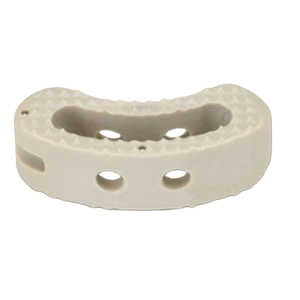E-mail iNfo@virkortho.shop Number +92-300-7477492

TLIF Cage
High-quality medical-grade spinal implant
TLIF Cage Introduction
The lumbar area of the spine may experience severe discomfort and functional limitations. The TLIF cage is one of the successful remedies that have been created as a result of improvements in surgical methods.
After the injured intervertebral disc has been removed, the TLIF cage is put into the disc space. The cage is intended to restore and maintain normal disc height, as well as to provide stability and fusion between the vertebrae.
TLIF Cage Sizes
The TLIF cage is a small, hollow device made of various materials such as titanium or polyetheretherketone (PEEK). TLIF cages come in a variety of shapes and sizes to meet the demands of the patient.
Titanium Mesh Cage are available in various diameters and lengths.
Diameters: 8MM, 10mm, 12mm, 14mm AND 16mm.
Lengths: 24mm, 28mm and 32mm
During a TLIF procedure, the surgeon enters the spine by a back incision. They cut a small gap between adjacent vertebrae by removing a part of the lamina (the bony arch of the vertebra). This enables access to the intervertebral disc space.
After the injured intervertebral disc has been removed, the TLIF Cage is put into the disc space. The cage is intended to restore and maintain normal disc height while also providing stability and vertebral fusion.
The TLIF Cage functions as a spacer, maintaining disc height and restoring vertebral alignment. It creates a stable environment for bone graft material to be implanted, encouraging vertebral fusion. The bone graft material grows and fuses with the neighbouring spinal bone during the fusion process, resulting in a solid, stable fusion mass.
TLIF Cage Advantage
Restoration of Disc Height: The TLIF cage aids in the restoration of the compressed disc’s height, easing strain on surrounding nerves and reducing discomfort.
Enhanced Fusion: The cage increases the chances of successful vertebral fusion by providing support and encouraging bone development.
Reduced Risk of Implant Migration: TLIF cages have elements such as screws or spikes that secure the cage in place, limiting the danger of migration and assuring perfect alignment.
Background: Posterior fusion procedures (posterior lumbar interbody fusion, PLIF; transforaminal lumbar interbody fusion, TLIF) are long-established surgical techniques for lumbar interbody fusion. They differ from anterior lumbar interbody fusion (ALIF) and extreme lateral interbody fusion (XLIF) procedures by approach and associated complications.
Objectives: The posterior fusion procedures PLIF and TLIF are presented and compared with other fusion methods, including advantages and disadvantages. Furthermore, the surgical technique and their complications are described. Based on the current literature, it is discussed which surgical techniques can be used in various cases.
Results: PLIF and TLIF procedures reduced back and leg pain, restored the sagittal profile of the lumbar spine, and achieved good fusion rates and long-term stability. Advantages of the TLIF procedure include shorter operative times, less blood loss, less intraoperative risk of injury to neural structures, and shorter convalescence. Compared with the interposition of a cage in the ALIF technique, a further step with the risk of vascular injury is eliminated.
Conclusions: The PLIF and TLIF procedures are almost equivalent posterior fusion procedures with high fusion rates, good long-term clinical outcomes, and low risk of complications. The TLIF procedure is slightly advantageous: lower nerve irritation rates, shorter operative times, and less extensive operation. Thus, the TLIF procedure is available for cases with single-sided pathologies and the PLIF procedure is available for bilateral compressions.
About
Exceptional orthopedic instruments and implants from Pakistan.
Contact
Portfolio
© 2025 All rights reserved.
Location
Quick Link